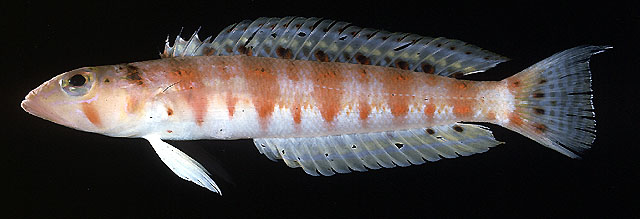|
Dorsal spines (total): 5-5; Dorsal soft rays (total): 21-21; Anal spines: 1-1; Anal soft rays: 17-17; Vertebrae: 30-30. This species is distinguished by the following characters: D V, 21; A I, 17; pectoral-fin rays 18; lateral-line scales 54; canine teeth 4 pairs, anteriorly in lower jaw; palatine teeth absent; vomerine teeth stout and in a single row; ctenoid scales on body, becoming cycloid in prepectoral and prepelvic areas; cycloid scales on opercle except above spine; cycloid scales on cheek, very small, many non-imbricate; preopercle margin smooth, with slight indentation at pore sites; body depth 5.75 in SL; head length 3.35 in SL; snout length 3.25 in HL; interorbital width 5.75 in HL; orbit diameter 3.8 in HL; fourth dorsal spine longest, 3.6 in HL; caudal fin slightly rounded on ventral half, truncate on dorsal half, with a prolonged upper lobe extending about two-thirds orbit diameter posterior to central margin of fin; pectoral fins 4.4 in SL; pelvic fins just reaching anus, 4.75 in SL; preserved color (in alcohol) pale yellowish with a large dark brown blotch above the opercle; 3 pairs of small dark brown spots dorsally on postorbital head with the middle pair largest, the posterior pair within anterior scaled area of nape; dorsal fin base, soft portion with a series of 8 dark brown spots; caudal fin has a vertical series of 4 dark spots; posterior part of anal fin with 3 basal dark spots; when fresh, color light reddish brown, grading to white ventrally, with 5 broad, triangular, dark reddish brown bars across body, and a narrow, uniformly wide, reddish brown bar between each pair of larger bars; 2 longitudinal rows of red spots within bars, 1 dorsal and 1 ventral, the red spot of dorsal row with a dark brown fleck or pair of flecks; postorbital head with dark brown spots; an oblique red bar on cheek; dark spots on fins (Ref. 75205). |
